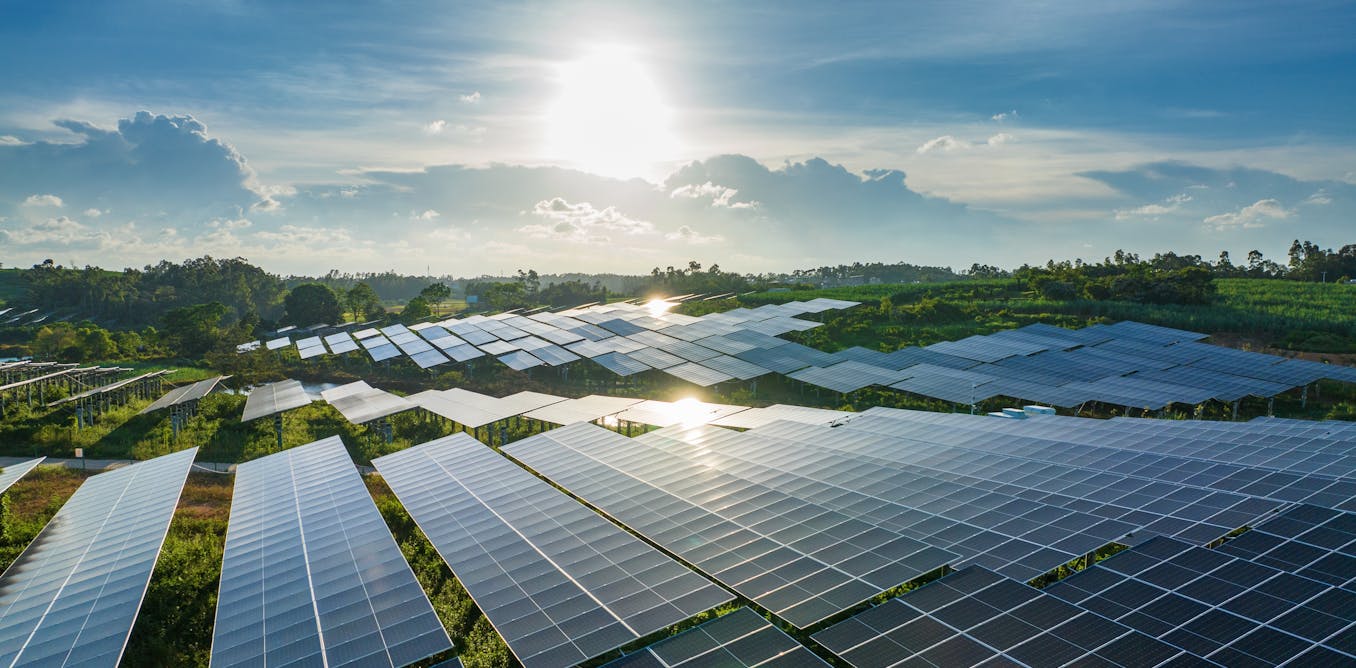Can Nanoparticles Help Fight Hunger? | Christy L. Haynes | TED
can Nanoparticles truly help fight hunger? In a thought-provoking TED talk by chemistry professor Christy L. Haynes, she explores the potential of nanoparticles in addressing the global food crisis. Drawing from her personal experience of growing up in a food-insecure household, she is driven to find innovative solutions for hunger.
Nanoparticles, which are extremely small materials, have unique chemical and physical properties that can be harnessed for various applications. Professor Haynes and her research group are developing silica nanoparticles that can be incorporated into plants to boost their immune response against diseases, pests, and poor soil conditions. By releasing silicic acid, these nanoparticles aim to strengthen plant cell walls and improve crop productivity.
Through greenhouse and field studies, Professor Haynes showcases the promising results of using silica nanoparticles on watermelon seedlings. The nanoparticles effectively dissolve and release silicic acid, leading to healthier plants and increased food production.
This groundbreaking research highlights the potential of nanoscience in revolutionizing agriculture and combating hunger on a global scale. With further development and implementation, nanoparticles could play a crucial role in ensuring food security for people around the world.
Watch the video by TED
Imagine you’re a farmer and you’ve planted enough crops to feed your family for the coming year. The weather is surprisingly good at the beginning of the growing season, but after those seeds are in the ground and the stalks start to peek up from the soil,
A disease that you cannot see cuts your expected yield in half. You think to yourself, “What will my family eat?” In the coming year, perhaps you’ll fumigate your soil, maybe you’ll add extra fertilizer. Maybe you’ll apply a fungicide or a pesticide hoping to decrease crop loss. You know that these traditional technologies work,
But you also know they have some negative implications for our ecosystem. This, of course, is not an imaginary scenario. We could feed every person on this planet if we didn’t lose so much to disease, pest and poor soil conditions. It’s estimated that we lose between 20 and 40 percent of crop productivity
Due to preventable disease and pest attack, and climate change is only making this worse. I stand here in front of you, a very unlikely person to help solve an agricultural crisis. I’m a chemistry professor who studies nanoparticles in sterile laboratories, I grew up in the desert,
And I don’t even keep houseplants, much less crops, alive. But I know that some of the best solutions to big problems come when folks from different or even opposing fields bring some of their simplest concepts together. And that is exactly what I think is possible here.
As I tell you that nanoparticles may be a critical part of the solution to our global food crisis. Let me tell you why I’m so intent on using nanoscience to fight hunger. We all have the issues that touch us deepest, and for me, it has always been hunger.
I find it intolerable that there are hungry people on this life-giving planet of ours. I can trace this, at least in part, to some of my own experience growing up. For a period of my childhood, I lived in a food-insecure household. We benefited from food shelf donations,
And we only ate what my mom could get with her hard work on double coupon day at the local supermarket. I loved the one day a month I was allowed to buy school lunch. Now, I don’t know why my parents didn’t apply for free school lunch or food stamps,
But the end situation was one where sometimes the refrigerator and the cupboards were empty. Now, it’s been a long time since I have worried about food for myself, but that feeling of being hungry is etched deep within me. I am driven to do something about hunger.
And the unusual talent that I bring to the task is my deep knowledge of designing and synthesizing nanomaterials that can carry molecular cargo and transform into specific chemical species. Let me stop and give a little bit of background about nanoscience. The prefix “nano” signifies a billionth,
So a nanometer is a billionth of a meter. In other words, nanoparticles are extremely small. You cannot see them with your naked eye or even a high-powered light microscope. In fact, you need a specialized instrument like the one you see here, called a transmission electron microscope, to even see nanoparticles.
Nanoparticles have actually been around forever. You can find naturally occurring nanoparticles in geological formations or in the aerosol particles that we breathe. But in the last few decades, scientists and engineers have gotten very excited about nanomaterials because we realized that as you shrink things down to the nanoscale,
Their chemical and physical properties can change drastically. For example, a material that’s usually unreactive when you shrink it down to the nanoscale can suddenly catalyze a whole host of chemical reactions. Or a material that doesn’t usually conduct electricity, suddenly does. As scientists tune the size, shape and chemical composition of a material,
They can tune those chemical and physical properties. Nanoscience gives us a seemingly unlimited palette of accessible chemical and physical properties. I’m sure you can imagine how useful that can be. And scientists have gotten very good at knowing exactly how to design nanomaterials to have the properties they want.
We are in a perfect moment to take advantage of all of the hard-won knowledge that has been systematically gained in laboratories around the world. And that’s already happening. You can find engineered nanoparticles in a range of products and applications, many of which are focused on some of our biggest sustainability challenges.
Personally, I like to work on the nanomaterials that make up the core of lithium-ion batteries for electric vehicles, but you’ll also find nanomaterials in water filtration technology, solar cells and even in clinical applications. With all of that background, now let me tell you about some of the nanomaterials
My research group is developing for agricultural applications. In some ways, the nanoparticles seem very simple. They’re made of silica or SiO2 in chemistry language. This is the same chemical composition that describes glass or sand. And the simple choice was not an accident. We wanted to work with Earth-abundant elements,
And you can’t do much better than silicon and oxygen on that front. The researchers in my lab are very skilled at designing silica nanoparticles with controlled size and surface chemistry. We also work hard to control the pore structure, because that determines the total surface area,
As well as the strength of the bonds that hold the nanomaterials together. That’s because all of those factors are critically important for our end goal, which is to get these nanoparticles inside plants, either by infiltrating seeds or by allowing them to pass through pores on the leaf surface, and then, once they’re internalized,
Having them transformed to release a molecule that the plant can use to protect itself from viruses, fungi or pest attacks. In technical terms, we want our silica nanoparticles to react with water in the environment and dissolve to release a molecule called silicic acid. You can think of silicic acid for plants
Like the multivitamin that you take every morning. Plants already contain silicic acid, they use it to build their cell walls. We want to deliver an extra boost of silicic acid, with the hypothesis that they’ll build stronger cell walls and boost their own immune response. So now, hopefully you can see the whole picture.
We design silica nanoparticles with the right size, shape and surface chemistry to be taken up into a plant. We also design them so that once they’re internalized, they dissolve to release enough silicic acid that the plants live healthier and longer, producing more food. With all of that background,
Now, let me actually show you some of the nanoparticles that we’re making and tell you about some of the early, exciting results from greenhouse and field studies. We’ve made many variations on the silica nanoparticle theme. Here you can see five electron microscope images of silica nanoparticles we’ve made.
All of them have the same scale bar, that’s just 100 nanometers. And all of them are small enough to go into the pores on a leaf’s surface. Here you can see some of the silica nanoparticles we’ve designed with various pore structures. The pore structure ends up being very important
Because the more water can react with the surface of the nanoparticle, the better it dissolves and the more silicic acid is released. Here you can see some nanoparticles we’ve designed to dissolve at different rates. And what you’re looking at is a nice, solid nanoparticle at the beginning, before it’s been exposed to water.
And then after eight, 16 and 24 hours, you can see those nanoparticles hollowing out, releasing lots of useful silicic acid. With all of these nanoparticles in hand, we started working with colleagues within the NSF Center for Sustainable Nanotechnology to start our first plant studies. The initial studies were very simple,
Using watermelon seedlings in a greenhouse. Here’s the experimental setup. We had watermelon seedlings that were going to be planted either in healthy soil or soil infested with Fusarium, a fungal soil-borne pathogen. Before planting them, we dipped them in our silica nanoparticles, and then we allowed them to grow in the greenhouse.
Of course, we also had a parallel set of plants that received no nanoparticles, growing in both healthy and diseased soil. So the goal was to figure out how that single application of silica nanoparticles impacted the plants growing in both healthy and diseased soil. And the results that we saw were really exciting.
We found that the plants that were growing in infected soil, that had received that one dose of silica nanoparticles were 30 to 40 percent healthier than the ones that had not. With this exciting result, we decided to try some field studies using the same soil conditions and the same nanoparticle conditions.
So we planted watermelon, either in healthy or infected soil, and we allowed them to grow for 100 days. We tracked the fungal disease, and we also measured the amount of fruit that was produced after 100 days. And what we found is that that one application of one to two milliliters of silica nanoparticles
Way back at the seedling stage, led us to a 70 percent increase in watermelon yield. Ideally, none of the nanoparticles would end up in the fruit that people are going to eat. So we analyzed the roots and the above-ground tissue and the edible fruit for any sign of silica nanoparticles.
We saw no increased silicon in the edible watermelon fruit, meaning that these nanoparticles did exactly what we designed them to do. Given the small amount of nanomaterials that we applied to each one of those plants, the cost per plant is only about two cents or 19 dollars for an acre.
This is a cost-effective treatment. By adding 19 dollar’s worth of nanoparticles to the average fertilizer cost of 250 dollars, a farmer would yield thousands of dollars increase in fruit production. With these exciting results in hand, we have a lot of other experiments planned and in progress.
We want to do multiple applications of nanoparticles and applications later in the growth process to see if that further increases our yield. We want to do studies on soybean and wheat, critical crops here in the Midwest and around the world. Two researchers in my lab recently applied silica nanoparticles
To potato plants in the field. They’re going to help harvest and analyze the results this fall. I hope that what you see is that this data is really compelling, and that nanoparticles have tons of potential to help decrease crop loss. And I only told you about silica nanoparticles.
I can imagine other important chemical compositions and even parallel application like remediation of soil pollutants. I ask you all to be open-minded about nanotechnology, encouraging funding agencies worldwide to invest. In the US, ask your senators and representatives to invest in the National Science Foundation,
The National Institutes of Health and the US Department of Agriculture for both basic and translational research. I know farmers are already embracing advanced technology in terms of robots and drones and implant sensors. I encourage them to embrace this advance as well. Now go back to imagining that you’re that farmer
And you’ve planted enough crops to feed your family for the coming year. You do all of the normal things, except this time, maybe you use seeds that were infiltrated with silica nanoparticles. Or maybe you go through once and you spray silica nanoparticles onto your crops.
As these tiny nanoparticles deliver a big boost of silicic acid from the inside, your plants overcome disease, and your family is fed. Let’s use all of the hard work that has been done on basic nanotechnology research to feed our global family for years to come. Thank you.
About TED
The TED Talks channel features the best talks and performances from the TED Conference, where the world’s leading thinkers and doers give the talk of their lives in 18 minutes (or less). Look for talks on Technology, Entertainment and Design — plus science, business, global issues, the arts and more. You’re welcome to link to or embed these videos, forward them to others and share these ideas with people you know.
Video “Can Nanoparticles Help Fight Hunger? | Christy L. Haynes | TED” was uploaded on 02/27/2024 to Youtube Channel TED




































